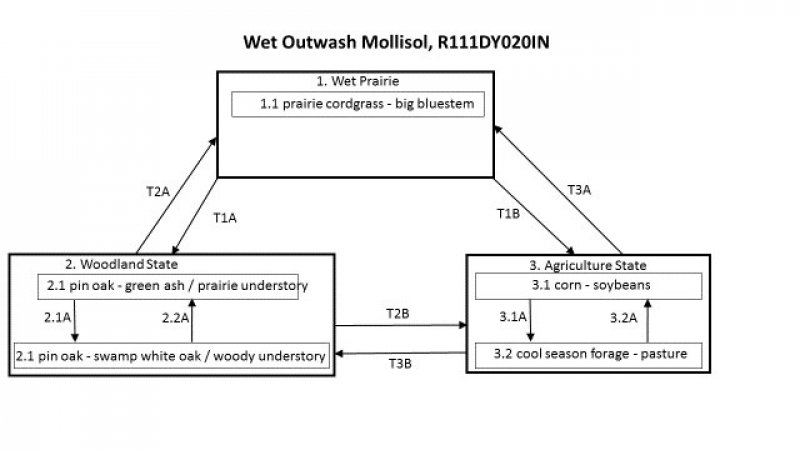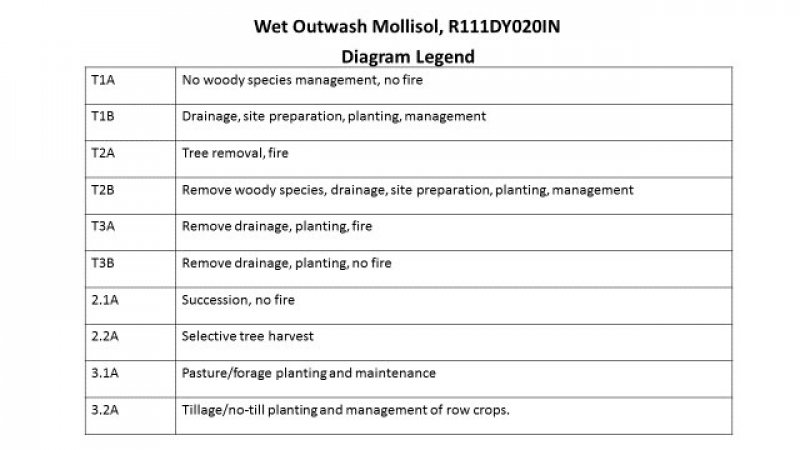
Natural Resources
Conservation Service
Ecological site R111XD020IN
Wet Outwash Mollisol
Last updated: 9/11/2024
Accessed: 12/21/2025
General information
Provisional. A provisional ecological site description has undergone quality control and quality assurance review. It contains a working state and transition model and enough information to identify the ecological site.
MLRA notes
Major Land Resource Area (MLRA): 111X–Indiana and Ohio Till Plain
A PROVISIONAL ECOLOGICAL SITE is a conceptual grouping of soil map unit components within a Major Land Resource Area (MLRA) based on the similarities in response to management. Although there may be wide variability in the productivity of the soils grouped into a Provisional Site, the soil vegetation interactions as expressed in the State and Transition Model are similar and the management actions required to achieve objectives, whether maintaining the existing ecological state or managing for an alternative state, are similar. Provisional Sites are likely to be refined into more precise group during the process of meeting the APPROVED ECOLOGICAL SITE DESCRIPTION criteria.
This PROVISIONAL ECOLOGICAL SITE has been developed to meet the standards established in the National Ecological Site Handbook. The information associated with this ecological site does not meet the Approved Ecological Site Description Standard, but it has been through a Quality Control and Quality Assurance processes to assure consistency and completeness. Further investigations, reviews and correlations are necessary before it becomes an Approved Ecological Site Description.
111D – Indiana and Ohio Till Plain, Western Part. This MLRA occurs in two separate areas. One area is in the west-central part of Indiana (73 percent), and the other is in southwestern Ohio (27 percent). The MLRA makes up 5,355 square miles (13,880 square kilometers). It includes the towns of Crawfordville, Delphi, Frankfort, Lafayette, and Liberty, Indiana, and Hamilton, Lebanon, Middletown, and Wilmington, Ohio. Interstates 65 and 74 cross the part of this area in Indiana, and Interstates 71 and 75 cross the part in Ohio. Shades and Turkey Run State Parks are in the part in Indiana, and Caesar Creek and Hueston Woods State Parks are in the part in Ohio. A small portion of the Wright-Patterson Air Force Base, in Ohio, is in the northern part of the area.
This area is in the Till Plains Section of the Central Lowland Province of the Interior Plains. It is dominated by loess hills and flats that are broken in places by moraines, kames, outwash plains, and stream terraces. Narrow, shallow valleys commonly are along the few large streams in the area. Elevation ranges from 530 to 1,050 feet (160 to 320 meters), increasing gradually from southwest to northeast. Relief is mainly a few meters, but in some areas hills rise as much as 100 feet (30 meters) above the adjoining plains.
The extent of the major Hydrologic Unit Areas (identified by four-digit numbers) that make up this MLRA is as follows: Wabash (0512), 68 percent; Great Miami (0508), 15 percent; Middle Ohio (0509), 14 percent; Scioto (0506,) 2 percent; and Upper Illinois (0712), 1 percent. Wildcat Creek in Indiana and the Little Miami River in Ohio have been designated as National Wild and Scenic Rivers. Sugar Creek and Walnut Creek occur in the part of the area in northern Indiana, and the Whitewater River is in the part in southeastern Indiana. The Sevenmile, Fourmile, and Great Miami Rivers cross the part of the area in Ohio.
Most of the eastern part of this MLRA is underlain by Late Ordovician shale and limestone. The western part is underlain by shale, siltstone, sandstone, limestone, and dolostone ranging in age from Middle Pennsylvanian to Silurian. Surficial materials include glacial deposits of till, outwash, and lacustrine sediments from Wisconsin and older glacial periods. A thin or moderately thick mantle of loess overlies much of the area.
Classification relationships
Major Land Resource Area (USDA-Natural Resources Conservation Service, 2006)
USFS Ecological Regions (USDA, 2007):
Sections –Central Till Plains, Beech Maple (222H), Interior Low Plateau-Shawnee Hills (223D), Interior Low Plateau-Bluegrass (223F), Central Till Plains-Oak Hickory (223G), Central Till Plains and Grand Prairies (251D)
Subsections -Bluffton Till Plains (222Ha), Miami-Scioto Plain-Tipton Till Plain (222Hb), Little Miami Old Drift Plain (222Hc), Mad River Interlobate Plains (222Hd), Crawford Uplands (223De), Crawford Escarpment (223Df), Northern Bluegrass (223Fd), Lower Wabash Alluvial Plain (223Gc), Southwest Indiana Glaciated Lowlands (223Ge), Eastern Grand Prairie (253Dd).
NatureServe Systems anticipated (NatureServe, 2011): Agriculture - Cultivated Crops and Irrigated Agriculture, Agriculture - Pasture/Hay, Allegheny-Cumberland Dry Oak Forest and Woodland, Central Interior Acidic Cliff and Talus, Central Interior Highlands Calcareous Glade and Barrens, Central Tallgrass Prairie, Clearcut - Grassland/Herbaceous, Introduced Upland Vegetation – Treed, Managed Tree Plantation, Mississippi River Riparian Forest, North-Central Interior and Appalachian Acidic Peatland, North-Central Interior Beech-Maple Forest, North-Central Interior Dry-Mesic Oak Forest and Woodland, North-Central Interior Dry Oak Forest and Woodland, North-Central Interior Floodplain, North-Central Interior Freshwater Marsh, North-Central Interior Maple-Basswood Forest, North-Central Interior Oak Savanna, North-Central Interior Wet Flatwoods, North-Central Interior Wet Meadow-Shrub Swamp, North-Central Oak Barrens, Northern Atlantic Coastal Plain Hardwood Forest ,Ruderal Forest, Ruderal Upland - Old Field, South-Central Interior / Upper Coastal Plain Wet Flatwoods, South-Central Interior Large Floodplain, South-Central Interior Mesophytic Forest, South-Central Interior Small Stream and Riparian, Southern Appalachian Oak Forest, Southern Interior Low Plateau Dry-Mesic Oak Forest, Successional Shrub/Scrub
LANDFIRE Biophysical Settings anticipated (USGS, 2010): Allegheny-Cumberland Dry Oak Forest and Woodland, Bluegrass Savanna and Woodland, Central Interior and Appalachian Floodplain Systems, Central Interior and Appalachian Riparian Systems, Central Interior and Appalachian Shrub-Herbaceous Wetland Systems, Central Interior and Appalachian Swamp Systems, Central Interior Highlands Calcareous Glade and Barrens, Central Interior Highlands Dry Acidic Glade and Barrens, Central Tallgrass Prairie, Great Lakes Coastal Marsh Systems, Mississippi River Alluvial Plain Dry-Mesic Loess Slope Forest, North-Central Interior Beech-Maple Forest, North-Central Interior Dry-Mesic Oak Forest and Woodland, North-Central Interior Dry Oak Forest and Woodland, North-Central Interior Maple-Basswood Forest, North-Central Interior Oak Savanna, North-Central Interior Wet Flatwoods, Paleozoic Plateau Bluff and Talus, Pennyroyal Karst Plain Prairie and Barrens, South-Central Interior Mesophytic Forest, South-Central Interior/Upper Coastal Plain Flatwoods, Southern Appalachian Oak Forest, Southern Interior Low Plateau Dry-Mesic Oak Forest
Ecological site concept
This site is an upland site formed on glacial outwash and colluvium parent materials in soils that are very poorly, poorly, or somewhat poorly drained. The soils surface color is dark (3/2 Munsell or darker) and extends beyond 10 inches, making them taxonomically mollisols. This site is found on flat portions (slope 0-2%) on outwash plains and terraces. Ponding to a depth of 15 inches occurs frequently for a range of duration between 2 and 30 days.
The characteristic vegetation of this site is of a depressional, tall-grass prairie that is dominated by prairie cordgrass, big bluestem, and a variety of sedge species. The combination of accumulation of organic material and seasonal changes in water which led to an increased probability of fire limited the encroachment of woody species. Fires occurred on this site every 5 years or less with the ignitions being a mix of lightning strikes those set by Native Americans. During the dormant season, these fires were less frequent and of lower intensity and size than those that occurred during the growing season. Grazing by ungulates had an effect on the productions and species diversity of this site, but the magnitude of the impact was less than that for prairies farther west. Reduction or in most cases elimination of fire as converted most of the site that is still in natural vegetation to that of a woodland or forest dominated primarily by oak and hickory species.
Currently, most of this site is in agricultural production, with the majority being used to raise corn and soybeans after the installation of drainage.
Associated sites
| R111XD019IN |
Outwash Integrade Located on adjacent landscapes; soil surface color is 3/2 Munsell or darker and extends to 10 inches or less. |
|---|---|
| R111XD021IN |
Dry Outwash Mollisol Located on adjacent landscapes; soil surface color is 3/2 Munsell or darker and extends greater than 10 inches; soils are moderately well to excessively drained. |
| F111XD017IN |
Outwash Upland Located on adjacent landscapes; soils surface is 3/2 Munsell or lighter; soils are somewhat poorly to moderately well drained. |
| F111XD018IN |
Dry Outwash Upland Located on adjacent landscapes; soils surface is 3/2 Munsell or lighter; soils are well to excessively drained. |
Similar sites
| R111XD001IN |
Shallow Muck Located on organic parent material that extends to less than 51 inches |
|---|---|
| R111XD007IN |
Till Depression Prairie Located on glacial till parent material and a concave landscape position; soils are 3/2 Munsell or darker to deeper than 10 inches and well drained. |
| R111XD012IN |
Till Ridge Prairie Located on glacial till parent material and a convex landscape position; soils are 3/2 Munsell or darker to deeper than 10 inches |
| R111XD026IN |
Sand Dune Prairie Located on sandy parent material on a dune landscape position; soils are 3/2 Munsell or darker and the color extends deeper than 10 inches |
Table 1. Dominant plant species
| Tree |
Not specified |
|---|---|
| Shrub |
Not specified |
| Herbaceous |
(1) Spartina pectinata |
Click on box and path labels to scroll to the respective text.

